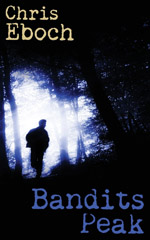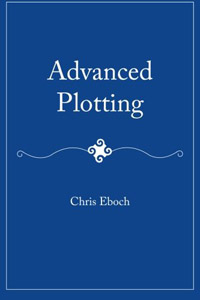by Chris Eboch
A strong story needs conflict. But conflict doesn’t just come from dramatic things happening. It comes from the character—what he or she needs and wants, and why he or she can’t get it easily.
Let’s start with a premise: a kid has a math test on Monday. Exciting? Not really. But ask two simple questions, and you can add conflict.
1. Why is it important to the character?
The stakes should be high. The longer the story or novel, the higher the stakes needed to sustain it. A short story character might want to win a contest; a novel character might need to save the world.
2. Why is it difficult for the character?
Difficulties can be divided into three general categories, traditionally called man versus man, man versus nature, and man versus himself. You can even have a combination of these. For example, someone may be trying to spy on some bank robbers (man versus man) during a dangerous storm (man versus nature) when he is afraid of lightning (man versus himself).
For our kid with the math test, here’s one example: It’s important because if he doesn’t pass, he’ll fail the class, have to go to summer school, and not get to go to football camp, when football is what he loves most. Assuming we create a character readers like, they’ll care about the outcome of this test and root for him to succeed.
Our football lover could have lots of challenges—he forgot his study book, he’s expected to baby-sit, a storm knocked out the power, he has ADHD, or he suffers test anxiety. But ideally we’ll relate the difficulty to the reason it’s important. So let’s say he has a game Sunday afternoon and is getting pressure from his coach and teammates to practice rather than study. Plus he’d rather play football anyway.
We now have a situation full of potential tension. Let the character struggle enough before he succeeds (or fails and learns a lesson), and you’ll have a story. And if these two questions can pump up a dull premise, just think what they can do with an exciting one!
Fears and Desires
As this exercise shows, conflict comes from the interaction between character and plot. You can create conflict by setting up situations which force a person to confront their fears. If someone is afraid of heights, make them go someplace high. If they’re afraid of taking responsibility, force them to be in charge.
You can also create conflict by setting up situations which oppose a person’s desires. If they crave safety, put them in danger. But if they crave danger, keep them out of it.
In my romantic suspense novel, Rattled (written as Kris Bock), Erin likes her adventures safely in books. But when she finds a clue to a century-old lost treasure, she’s thrust into a wilderness expedition full of dangers from wild animals, nasty humans, and even nature. In my Mayan historical novel The Well of Sacrifice, Eveningstar never dreams of being a leader or a rebel. But when her family, the government, and even the gods fail to stop the evil high priest, she’s forced to act. The reluctant hero is a staple of books and movies because it’s fun to watch someone forced into a heroic role when they don’t want it. (Think of Han Solo in Star Wars.)
Even with nonfiction, you can create tension by focusing on the challenges that make a person’s accomplishments more impressive. In Jesse Owens: Young Record Breaker, I made this incredible athlete’s story more powerful by focusing on all the things he had to overcome—childhood health problems, poverty, a poor education. I showed his successes and his troubles, to help the reader understand what he achieved.
Some writers start with plot ideas and then develop the character who’ll face those challenges, while others start with a great character and then figure out what he or she does. Regardless, remember to work back and forth between plot and character, tying them together with conflict.
To Build Conflict:
What does your main character want? What does he need? Make these things different, and you’ll add tension. It can be as simple as our football player who wants to practice football, but needs to study. Or it could be more subtle, like someone who wants to be protected but needs to learn independence.
Even if your main problem is external (man versus man or man versus nature), consider giving the character an internal flaw (man versus himself) that contributes to the difficulty. Perhaps your character has a temper, is lazy, or refuses to ever admit she’s wrong. This helps set up your complications and as a bonus makes your character seem more real.
Before you start, test the idea. Change the character’s age, gender, or looks. Change the point of view. Change the setting. Change the internal conflict. What happens? Choose the combination that has the most dramatic potential.
 Chris Eboch writes fiction and nonfiction for all ages. In Bandits Peak, a teenage boy meets strangers hiding on the mountains and gets drawn into their crimes, until he risks his life to expose them. The Eyes of Pharaoh is an action-packed mystery set in ancient Egypt. The Genie’s Gift is an Arabian Nights-inspired fantasy adventure. In The Well of Sacrifice, a Mayan girl in ninth-century Guatemala rebels against the High Priest who sacrifices anyone challenging his power. Her writing craft books include You Can Write for Children: How to Write Great Stories, Articles, and Books for Kids and Teenagers and Advanced Plotting.
Chris Eboch writes fiction and nonfiction for all ages. In Bandits Peak, a teenage boy meets strangers hiding on the mountains and gets drawn into their crimes, until he risks his life to expose them. The Eyes of Pharaoh is an action-packed mystery set in ancient Egypt. The Genie’s Gift is an Arabian Nights-inspired fantasy adventure. In The Well of Sacrifice, a Mayan girl in ninth-century Guatemala rebels against the High Priest who sacrifices anyone challenging his power. Her writing craft books include You Can Write for Children: How to Write Great Stories, Articles, and Books for Kids and Teenagers and Advanced Plotting.
Learn more at www.chriseboch.com or her Amazon page, or check out her writing tips at her Write Like a Pro! blog. Sign up for her Workshop newsletter for classes and critique offers.
Chris also writes novels of suspense and romance for adults under the name Kris Bock; read excerpts at www.krisbock.com.
This article was originally published in the June 2011 issue of SouthWest Sage and is reprinted here by permission of the author.



























Leave a Reply